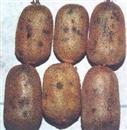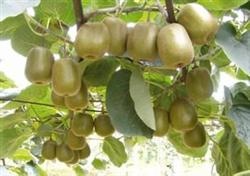High-yield techniques of kiwifruit

First, varieties should be selected with large fruit shape, good quality, strong disease resistance and good yield, such as Hayward, Allison, Bruno and so on. Second, the kiwifruit in the selected garden likes a cool and humid environment, and is afraid of drought, waterlogging, wind and cold, but it is not resistant to the late frost in early spring, so the kiwifruit orchard in the mountain area should be selected in the leeward slope or open land. The soil should be loose, good drainage, high content of organic matter, pH 5.5-6.5 slightly acidic sandy loam. Third, the cultivation method should dig the planting hole before planting, with a diameter of 1 meter and a depth of 40-50 cm, with 40-60 kg of compost, 20 g of phosphate fertilizer and 400 g of calcium-magnesium phosphate fertilizer. The planting time can be from defoliation in autumn to before sprouting in spring, but it is better before the shoot bleeding period in late October in autumn and late February in spring. The row spacing is 4.6 × 6.0 m. In order to increase the early yield, close planting according to 2 times the number, thinning after mature, and mixed planting of 20% of pollinated male plants. 4. Scaffolding is generally used to cultivate scaffolding, including scaffolding, arch bridge tunnel scaffolding and fence, and horizontal scaffolding is the most suitable. Fifth, summer management after sprouting in summer, the overgrown lateral vines should be erased. From June onwards, always tie up the new tips so that they are evenly covered with noodles. As a result, 10-15 nodes were left in the branches, 15-20 nodes were left in the vegetative branches, and the rest were removed. 6. Artificial pollination and fruit thinning first dilute the pollen of male flowers to 10 times with stone pine nuts, and then pollinate with cotton sticks. In addition, the male flower branch can be attached to the female branch, or the insect can transmit pollen. The standard of flower thinning and fruit thinning is as follows: one fruit per node on the fruiting branch, one lateral fruit and the middle fruit. The leaf-fruit ratio can also be used as the standard, that is, one fruit is left for every 4-5 leaves. Generally speaking, 20 cm long weak fruit branches leave 1-2 fruits, 20-60 cm long fruit branches leave 3-4 fruits, and fruit branches above 60 cm leave 5-6 fruits, leaving 20,000 fruits per 1.5 mu. Winter pruning is carried out from late December to late February of the following year. After winter pruning, there are generally 3-4 fruit branches and 15-16 buds per mu. The structure of each tree is as follows: 1 trunk, 2 main branches, 3 secondary main branches, 26 lateral branches, 90 fruiting mother branches and 315 fruiting branches. Eighth, the scientific harvest of kiwifruit is carried out from mid-September to mid-October. At this time, the fruit is fully ripe and ready for picking. Pick and handle gently when picking, and avoid squeezing and bruising when stacking. It can only be eaten after 8-10 days of ripening after harvest. 9. It is said that monkey peach has strong disease resistance and insect resistance, and its main pests are leafhopper, bean moth and scale insects. Corresponding measures should be taken to do a good job of control.
- Prev

Occurrence regularity and control of Botrytis cinerea in kiwifruit
Botrytis cinerea of kiwifruit mainly occurred in flowering stage, young fruit stage and storage period of rhesus monkey. In severe years, the incidence of orchard and storage period can reach more than 50%. Botrytis cinerea has become one of the main diseases affecting the healthy development of kiwifruit industry. First, the symptoms of young fruit (late May to early June) when the onset, disability.
- Next

Key points of management techniques of kiwifruit in summer
1. The main reasons for leaf wilting of anti-wilting kiwifruit during high temperature in summer are as follows: one is high temperature and drought, which mostly occurs from 12:00 to 4 pm in sunny days, and recovers sooner or later, usually in a large area. This kind of situation should be irrigated in time in the morning and evening, and the wilting can be relieved. Second, the root system suffers from root rot.
Related
- Moge, come on! The staff of the peasant association in the producing area of cantaloupe were frightened when the crowd gathered.
- Causes and Solutions of low Fruit setting rate of Apple
- Symptoms and control measures of passion fruit virus disease
- Fruit growing lesson: how do apple orchards keep high yields?
- Can you build orchards in the mountains? What are the pros and cons?
- How to manage the coloring period of Crisson grape?
- This paper introduces the processing technology of two kinds of fig products.
- How much is a month for retired teachers in rural areas by 2020?
- How can strawberry planting increase sugar content? We should pay attention to management in many aspects.
- What are the cultivation techniques on how to improve the yield of golden fruit?

